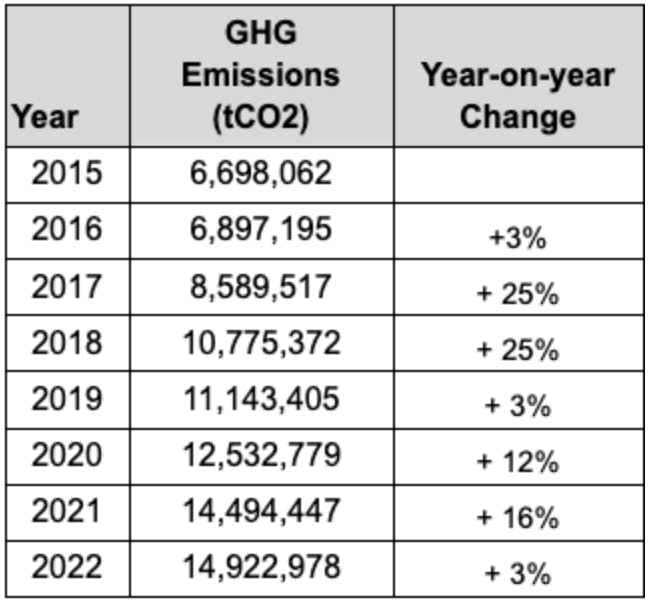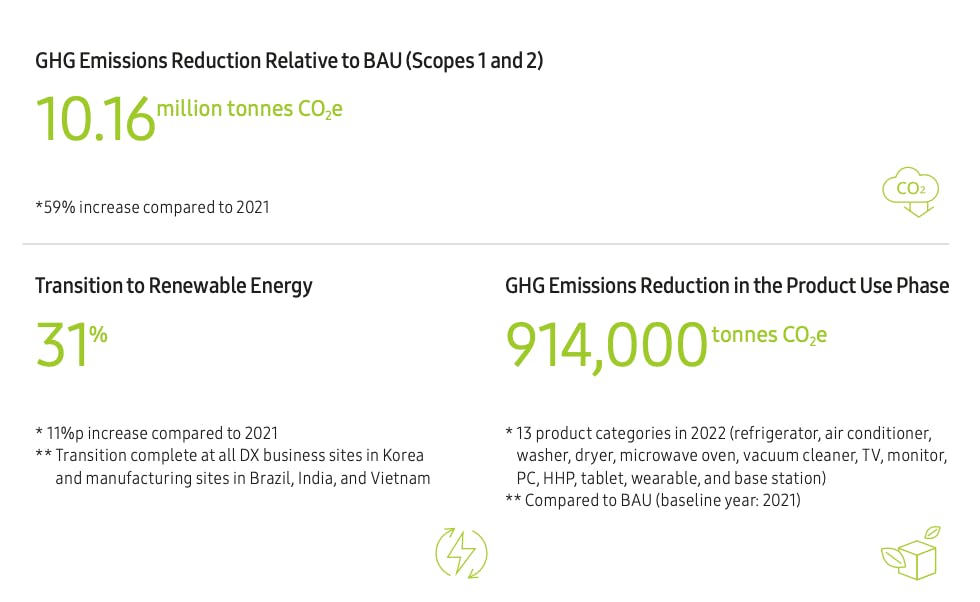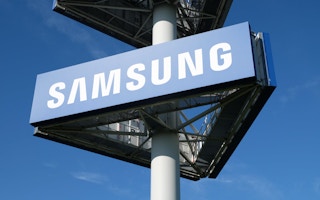Samsung Electronics, one of the world’s most influential tech companies, has come under fire from environmental groups for enlarging its domestic climate footprint in the same year that it made a global commitment to decarbonise and switch to renewable energy.
To continue reading, subscribe to Eco‑Business.
There's something for everyone. We offer a range of subscription plans.
- Access our stories and receive our Insights Weekly newsletter with the free EB Member plan.
- Unlock unlimited access to our content and archive with EB Circle.
- Publish your content with EB Premium.
The maker of the popular Galaxy mobile phone saw its year-on-year greenhouse gas emissions grow by 3 per cent in South Korea in 2022 – to 14.9 million tonnes of carbon dioxide equivalent (tCO2) – just as the company had pledged to use only clean energy in all international markets outside of Korea by 2027.
The clean energy-only commitment was part of the firm’s plan to reduce its Scope 1 and Scope 2 emissions to net-zero by 2050, the year by which the company is also targeting the use of 100 per cent renewable energy everywhere, including in its home market, where it consumes roughly two-thirds of the energy it uses globally.
Samsung said when it launched its net-zero commitment that South Korea is “one of the most challenging countries” for sourcing renewable energy, as options for renewables procurement are limited in the coal-dependent country.
Samsung reported in its 2023 sustainability report that 31 per cent of its electricity was derived from renewable sources in 2022, an increase from 20 per cent in 2021. But New Climate Institute (NCI), a think tank, noted that the company relies too heavily on renewable energy certificates – that is, tradable certificates that represent electricity generated by renewable energy – rather than generating clean energy itself by installing solar panels on its factories or through corporate power purchase agreements (PPAs) for renewables.
“
One year after Samsung issued its global renewable energy commitment, the results are disappointing. In 2022, Samsung’s greenhouse gas emissions in South Korea increased compared to one year prior, an unfortunate step backwards in our fight against climate change.
Daul Jang, advocacy specialist, Greenpeace South Korea

Samsung Electronics’s 2015-2022 greenhouse gas emissions. Source: National GHG Management System (NGMS), Korea
Even in geographies outside of Asia, where renewable energy is more easily available, Samsung has chosen to buy RECs over purchasing renewable energy directly to reduce its Scope 2 emissions, and has claimed that its energy transition is complete in these territories, NCI noted.
Samsung’s renewable energy procurement claims contrast the “more transparent and constructive” communications from its competitors, NCI said. Like Samsung, Apple claims to have powered its United States operations with 100 per cent renewable energy. But while 77 per cent of Apple’s renewable electricity was sourced via self-generation and PPAs, Samsung’s share of “high-impact” procurement was just 6 per cent.
Environmental group Greenpeace also criticised Samsung’s emissions reduction commitments. Daul Jang, advocacy specialist for Greenpeace South Korea, said: “Climate commitments are critical, but they need to be met with real action. We need Samsung to opt for high-impact sourcing methods worldwide, such as PPAs and direct investment in renewable energy.”
Samsung’s mid-century target for 100 per cent renewable energy is “relatively weak”, as limiting global warming to the climate-critical 1.5°C will mean achieving net-zero in wealthy Organisation for Economic Co-operation and Development (OECD) countries like South Korea by 2030, not 2050, NCI said.
Big emissions reductions or accounting trickery?

In Samsung’s 2023 sustainability report, the brand claims to have reduced emissions by 59 per cent and increased renewable energy use by 31 per cent in a year [click to enlarge]. Source: Samsung Electronics 2023 sustainability report
Samsung claims to have reduced its Scope 1 and 2 emissions by 59 per cent between 2021 and 2022, cutting some 10.16 million tCO2, although the company uses a comparison with “business-as-usual (BAU)”, which NCI said was not clearly defined.
Using a location-based accounting method, where electricity emissions are reported based on the local grid, Samsung’s Scope 1 and 2 emissions were only 1.5 per cent lower in 2022 than in 2021 – and 13 per cent higher than in 2020 – NCI said.
Including Scope 3, or full value chain emissions, Samsung’s overall emissions footprint grew by about 1 per cent, according to NCI’s calculations.
However, including Scope 3 emissions in its climate calculations is a sign of progress and represents a “significant improvement” in the transparency of Samsung’s climate strategy, NCI said. Samsung’s Scope 3 emissions total 124.7 MtCO2e in 2022, mostly from the downstream use of sold products, its sustainability report reads.
In its sustainability report, the tech giant insists that it is still on the path toward achieving net zero by 2050.

















